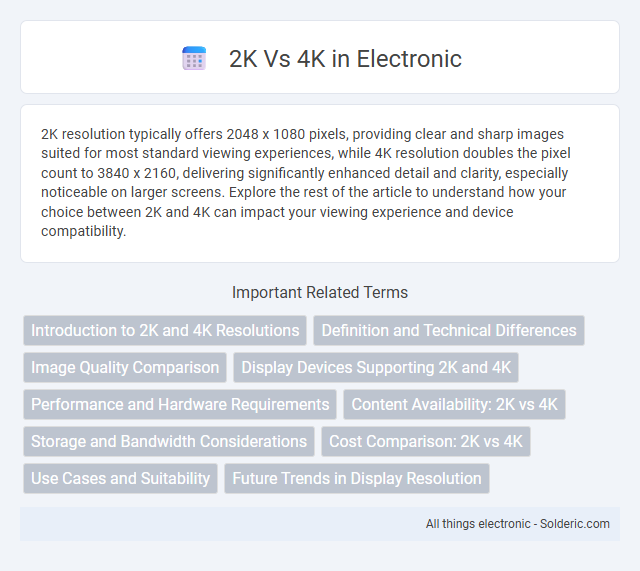2K resolution typically offers 2048 x 1080 pixels, providing clear and sharp images suited for most standard viewing experiences, while 4K resolution doubles the pixel count to 3840 x 2160, delivering significantly enhanced detail and clarity, especially noticeable on larger screens. Explore the rest of the article to understand how your choice between 2K and 4K can impact your viewing experience and device compatibility.
Comparison Table
| Feature | 2K Resolution | 4K Resolution |
|---|---|---|
| Resolution | 2048 x 1080 pixels | 3840 x 2160 pixels |
| Pixel Count | 2.2 million pixels | 8.3 million pixels |
| Aspect Ratio | Approx. 17:9 | 16:9 |
| Image Clarity | Good for cinema and gaming | Sharper, detailed images |
| Use Case | Digital cinema, mid-range displays | High-end TVs, monitors, streaming |
| Hardware Requirement | Moderate GPU power needed | High GPU power needed |
| Bandwidth Consumption | Lower data usage | Higher data usage |
Introduction to 2K and 4K Resolutions
2K resolution typically refers to a display resolution of approximately 2048 x 1080 pixels, commonly used in digital cinema and some high-definition displays. 4K resolution, offering about 3840 x 2160 pixels, delivers four times the pixel count of Full HD, providing sharper images and enhanced detail for entertainment and professional use. When choosing your display, understanding the difference in pixel density between 2K and 4K can significantly impact your viewing experience, especially on larger screens.
Definition and Technical Differences
2K resolution refers to a display with approximately 2,000 horizontal pixels, typically 2048x1080, whereas 4K resolution has about 4,000 horizontal pixels, usually 3840x2160 or 4096x2160. The technical difference lies in pixel density, where 4K offers four times the pixel count of 2K, resulting in sharper images and finer detail. Your choice between 2K and 4K affects image clarity, screen size suitability, and hardware requirements for optimal performance.
Image Quality Comparison
4K resolution offers four times the pixel count of 2K, resulting in significantly sharper and more detailed images, especially noticeable on larger screens. The increased pixel density of 4K enhances clarity, reduces pixelation, and delivers more vivid colors and finer textures. In contrast, 2K resolution, while sufficient for smaller displays, cannot match the immersive visual experience and precision provided by 4K technology.
Display Devices Supporting 2K and 4K
Display devices supporting 2K resolution include many computer monitors, laptops, and mid-range televisions, typically offering a resolution of 2560x1440 pixels, which provides sharper images than standard Full HD. In contrast, 4K-compatible devices, such as high-end TVs, gaming monitors, and professional digital cinema cameras, support a resolution of 3840x2160 pixels, delivering four times the pixel count of 2K for ultra-clear visuals. The increasing availability of 4K displays across various platforms has driven widespread adoption in gaming, streaming, and content creation sectors.
Performance and Hardware Requirements
4K resolution demands significantly more GPU power and VRAM compared to 2K, often requiring high-end graphics cards like the NVIDIA RTX 3080 or AMD RX 6800 XT to maintain smooth frame rates in modern games. Performance in 4K gaming typically drops to around 50-60% of the frame rate seen at 2K due to the quadrupled pixel count, stressing both the GPU and CPU. Hardware requirements also include faster storage solutions such as NVMe SSDs to handle larger texture files and support seamless loading times essential for 4K content.
Content Availability: 2K vs 4K
4K content availability has significantly increased with streaming platforms like Netflix, Amazon Prime, and Disney+ offering numerous movies and series in 4K resolution, while 2K content remains more common in traditional broadcasting and older digital files. 4K content requires higher bandwidth and compatible devices, influencing its gradual adoption compared to widespread 2K content that supports lower data rates. Gaming and digital cinemas frequently use 2K resolution, but the expanding 4K ecosystem is rapidly bridging the content gap for consumers seeking ultra-high-definition experiences.
Storage and Bandwidth Considerations
4K video requires four times the storage space and bandwidth compared to 2K, significantly impacting data management and streaming performance. Your devices and internet connections must support higher bitrates to handle 4K content smoothly without buffering or quality loss. Efficient compression codecs like HEVC can help reduce the storage and bandwidth demands of 4K files while maintaining high visual quality.
Cost Comparison: 2K vs 4K
2K displays generally cost 30-50% less than 4K monitors, making them a budget-friendly option for users prioritizing affordability without sacrificing decent resolution. The manufacturing complexity and higher pixel density of 4K panels contribute to their increased price, often ranging from $300 to $1000 or more compared to 2K models that typically fall between $200 and $600. For professional applications requiring ultra-high detail, the added cost of 4K is justified, but for casual use and gaming, 2K offers a more cost-effective balance between price and performance.
Use Cases and Suitability
2K resolution, typically 2048x1080 pixels, is ideal for digital cinema, gaming, and streaming where bandwidth and hardware limitations exist. 4K resolution, at 3840x2160 or higher, offers superior detail and clarity, making it suitable for professional video editing, large screen displays, and immersive gaming experiences. Your choice depends on the device capabilities and the level of visual fidelity required for optimal performance and viewing pleasure.
Future Trends in Display Resolution
4K resolution is rapidly becoming the new standard in display technology due to its higher pixel density, offering four times the detail of 2K, which results in sharper images and enhanced visual clarity for users. Emerging trends suggest that 8K and beyond will drive innovation, incorporating advanced HDR capabilities and higher frame rates to support immersive experiences in gaming, streaming, and professional applications. Market adoption is further accelerated by decreasing costs of 4K panels and increasing content availability, signaling a clear shift towards ultra-high-definition displays as future mainstream resolution standards.
2K vs 4K Infographic

 solderic.com
solderic.com